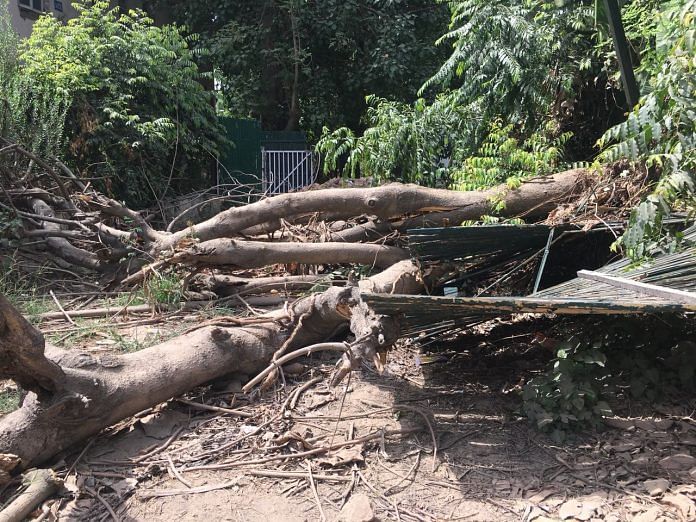A government-owned resource should have a higher public purpose – one that responds to the needs and aspirations of the city.
The central government’s plan to cut approximately 16,500 trees in south Delhi has recently gained public attention. This is part of a larger plan to replace walk-up government housing in three colonies with high rise housing for government employees, plus commercial real estate that will be placed on the market to finance the construction costs of the new housing.
The projects in Sarojini Nagar, Nauroji Nagar and Netaji Nagar will cover a total area of 379 acres, and the total housing stock of 8,087 government-owned flats will be replaced by 15,510 flats (of varying sizes), along with associated social infrastructure. In exchange, the developer (the National Building & Construction Corporation, a government-owned enterprise) will get to develop approximately 8,00,000 square metres of commercial real estate, which it will auction to recover the construction cost of the project, expected to be in the region of Rs 24,682 crore.
Delhi’s environmentalists, citizens groups and resident welfare associations have vociferously protested the felling of so many fully-grown trees in a city that has the worst air quality in the world. Responding to this, the ministry of housing and urban affairs has recently issued clarifications that trees will “henceforth” not be felled, and promised to plant one million trees within the next three months. The minister has even invited citizen groups to opine on locations for compensatory afforestation.
Meanwhile, the rationale of these projects, except as a way to finance housing for central government employees, has never been publicly stated and discussed. Shouldn’t an area as large as this in the heart of the national capital, and one that is a government-owned resource, have a higher public purpose – one that responds to the needs and aspirations of the city?
Concealed from public view
The government could use some part of this resource to respond to the intense shortage of formal-sector affordable housing in the city, and to create new forms of urban living and working that address Delhi’s over-reliance on private cars and its lack of quality public spaces, especially safe streets for women and children.
We understand that the government is not legally bound to establish a wider public purpose for these projects, or even to discuss them with the public or communities of experts. Perhaps India’s community of architects and urban designers could suggest ways to make more innovative use of the land and resources, not just to build around the existing green cover but to create public infrastructure to enhance the quality of life in the city.
As it is, the project documents (or whatever we could access, since much is concealed from public view) make the briefest mention of issues of sustainability and design. In terms of the agreement between the Government of India and NBCC, the latter is responsible for getting design and plan approvals, whereas an Empowered Committee headed by the urban development ministry’s secretary is required to approve designs and plans.
The NBCC is also responsible for “incorporating various green building features”, which include “dedicated vehicle parking”, as per conditions stipulated in the environmental clearance.
The environment clearance documents, however, mandate a comprehensive mobility plan, with various sustainable transport features. It is not clear yet, from the terms of the agreement between the government and the NBCC, how various environmental conditions will be met, other than a blanket statement in the NBCC agreement that passes on the entire job to it. There is also no public information about the green building features or any other architecture and design innovations that have been incorporated into the projects.
The paucity of public information contrasts strikingly with the ubiquitous signage advertising the positive features of these projects as you drive by the sites. In Nauroji Nagar, a blow up of the 3D renderings of the proposed ‘world-class’ World Trade Centre is meant to entice buyers of commercial space, while residential developments are designed like high-end gated communities such as those in the swankier parts of Gurgaon and Noida. In every possible way, the government seems to be trying hard to emulate private sector developers, but it is our case that the government-as-developer should be held accountable to a higher standard of public purpose in its handling of public assets.
Extra responsibility
As the custodian of the Master Plan of Delhi 2021 via the Delhi Development Authority, the central government is responsible for the planning the capital city “within a framework of sustainable development, public-private and community participation and a spirit of ownership and a sense of belonging among its citizens.” Significantly, in Delhi, the DDA holds monopoly over this function – private developers have not been permitted in the land development business for several decades now.
Moreover, legal and regulatory regimes for land in Delhi have ensured that no private party could possibly ever mobilise such a large parcel of land in a central location in Delhi. These factors imbue the central government’s role as a developer in the national capital with an additional sense of responsibility.
In other words, while redeveloping such significant parcels of land, the government is morally bound to deal with this land in the best interests of the city as a whole, and not just as a private proprietor would. In doing this, the government could also learn from global experience – both good and bad – in urban redevelopments and the role it has in re-making the city through quality urban design.
We ask at this stage for an opening up of dialogue on the pending projects, and a review and redesign that take into account the role of these projects in the life of the city, specifically their potential to enhance sustainable public infrastructure.
Mukta Naik is a senior researcher and Arkaja Singh is a fellow at the Centre for Policy Research.



